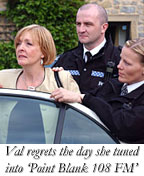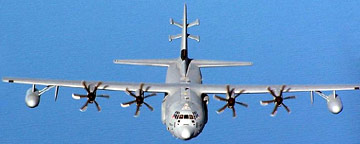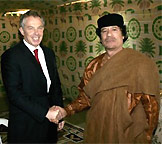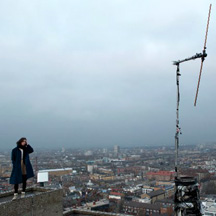Sunday 27 May, 2012, 17:50 - Pirate/Clandestine
Posted by Administrator
A report recently arrived on the Wireless Waffle newsdesk of the discovery of some kind of (probably illegal) transmitter discovered on land in Surrey next to a military establishment. According to the report:Posted by Administrator
Army bomb disposal experts were called to Camberley on Monday morning to deal with a "suspicious" object that turned out to be a radio device... Shortly before 3pm, Surrey Police said the unit had been confirmed to be a "transmitter or repeater for a citizen or pirate band radio station", and that roads had been reopened and cordons lifted.
Of course this piqued the interest of the Wireless Waffle team. Let's look at the possible options:
CB Repeater
Such things do exist but require a great deal of technical skill to install and operate. As CB radio operates at 27 MHz, they generally require large antennas, and as transmitter powers are usually at least 4 Watts, need power supplies the kind of size that wouldn't easily be left lying around in a piece of woodland.
Probability rating: ***** (2 out of 5)
Pirate Repeater
Not something that is often heard of, in fact, do a 'google' search and nothing of any substance comes up. One possibility is that it could have been a PMR446 repeater which, whilst not strictly legal, is not fully pirate as it operates on an unlicensed basis. Such devices would (sensibly) be located on high ground, though they could be operated from batteries for some time. Ideally, they would be high off the ground too (the news report does not indicate whether the so-called repeater was on the floor or up a tree).
Probability rating: ***** (1 out of 5)
FM Pirate Transmitter
 Most FM pirate stations in the UK use transmitters on top of tower-blocks. The area in question is clearly not one bedecked with such skyscrapers, it is woodland. It is not unheard of for pirates to put transmitters up trees but there are better places, especially those with power and somewhere dry to put the transmitter. There aren't that many pirates in this area, Point Blank FM was one which used to broadcast specifically to the area but it hasn't been on air in that part of the world for many months. Pressure FM (also known as 'Presha') is another station in that part of the world. It is possible they would use a site such as that, but if they were locals, presumably they would know the area was largely military and steer clear of it?
Most FM pirate stations in the UK use transmitters on top of tower-blocks. The area in question is clearly not one bedecked with such skyscrapers, it is woodland. It is not unheard of for pirates to put transmitters up trees but there are better places, especially those with power and somewhere dry to put the transmitter. There aren't that many pirates in this area, Point Blank FM was one which used to broadcast specifically to the area but it hasn't been on air in that part of the world for many months. Pressure FM (also known as 'Presha') is another station in that part of the world. It is possible they would use a site such as that, but if they were locals, presumably they would know the area was largely military and steer clear of it?Probability rating: ***** (4 out of 5)
Short-Wave Pirate Transmitter
Short-wave pirates are almost uniquely confined to woodlands in order to string up the large antennas necessary given the frequencies they use. They often use hidden battery powered equipment. On the face of it then, this is exactly the kind of place you would expect to find such a transmitter. The bigger question is whether any such pirates operate from that part of the country, the answer to which is, of course, 'who knows?' Certainly there is some history in the area including Radio Fax which used to operate from Surrey in the late 1980s, and of course, the infamous Radio Jackie which used to operate from the London end of Surrey. There's also a vague recollection of a maildrop for short-wave pirates that was in that part of the world (though my memory is a bit hazy on that). Anyhow, it's not impossible but the number of UK-based short-wave pirates seems very much in decline.
Probability rating: **** (3 out of 5)
Our conclusion then - probably an FM pirate - but a bit of a stupid one to go so near to ministry of defence land!
2 comments
( 2045 views )
| permalink
| 



 ( 2.9 / 105368 )
( 2.9 / 105368 )




 ( 2.9 / 105368 )
( 2.9 / 105368 )
Wireless Waffle has talked extensively about pirate radio in the past, from short-wave music stations, to Brazilian sat-jackers. But it seems that, of all the nations on the planet, the Russians hold the baton for being the biggest pirates of them all.
This story begins when reading the latest intruder report from the IARU Region 1 Monitoring System. The report indicated that there had been an intrusion into the 80 metre amateur band between 3.5 and 3.6 MHz by Russian pirate stations running AM. Now historically the Voice of Korea (the North Korean broadcaster) has been transmitting in the 80 metre band (or the 75 metre band as it's called in in North America) on 3560 kHz in AM and the immediate assumption was that these new signals couldn't possibly be Russian pirates, but must be the Voice of Korea and perhaps a few other stations trying to jam it. The IARU report, however, says that the carriers are very unstable and that the modulation is voices in Russian.
 So the only thing to do to verify this story is to turn on a receiver and have a listen. Having done this, there were no obvious signals in the 80 metre amateur band. Having previous heard pirates just below the band at around 3450 kHz, the tuning dial was slowly rotated to ever lower frequencies. Nothing. And then, at 3175 kHz, something. A weak carrier... no, two carriers alternating... both rather unstable in frequency. Switching the receiver to AM yielded weak modulation. A bit more tuning, to 3125 kHz and a much stronger AM signal with a Russian voice and a wobbly carrier. Hey presto!
So the only thing to do to verify this story is to turn on a receiver and have a listen. Having done this, there were no obvious signals in the 80 metre amateur band. Having previous heard pirates just below the band at around 3450 kHz, the tuning dial was slowly rotated to ever lower frequencies. Nothing. And then, at 3175 kHz, something. A weak carrier... no, two carriers alternating... both rather unstable in frequency. Switching the receiver to AM yielded weak modulation. A bit more tuning, to 3125 kHz and a much stronger AM signal with a Russian voice and a wobbly carrier. Hey presto!
But what are these odd signals? Are they military operators in a private net (if so, why AM and why unencrypted)? Are they some kind of harmonics or intermodulation? Googling didn't bring much until a page on Sparky's Web Blog was found. It seems that these are effectively the equivalent of Russian CBers but presumably using much lower frequencies given the large distances between Russian cities. The band is known as the тройка band ('troika' in English which has several meanings from 'three of a kind' to a sledge or fairground ride). The band runs from approximately 2900 to 3200 kHz which are internationally allocated to the Aeronautical Mobile and Mobile services.
 There are aeronautical frequency assignments in the band (2872, 2899, 2921, 2962 and 3016 are frequencies assigned to North Atlantic traffic for example), but these lower frequencies are less often used unless propagation makes it totally necessary. Oddly, the various frequency lists for the band show very little aeronautical use in Russia (other than Irkutsk on 3016 kHz) - a coincidence? Probably the pirates know this and therefore feel free to mess about in the aviation bands, knowing that the Russian authorities are likely to be little interested in their activities.
There are aeronautical frequency assignments in the band (2872, 2899, 2921, 2962 and 3016 are frequencies assigned to North Atlantic traffic for example), but these lower frequencies are less often used unless propagation makes it totally necessary. Oddly, the various frequency lists for the band show very little aeronautical use in Russia (other than Irkutsk on 3016 kHz) - a coincidence? Probably the pirates know this and therefore feel free to mess about in the aviation bands, knowing that the Russian authorities are likely to be little interested in their activities.
If you're in Europe, when it gets dark (and lower frequency propagation opens up over the continent), why not give them a listen. It's fun to chase the carriers up and down in frequency. If you speak Russian, perhaps you could provide some translation as to what on earth they are talking about!
P.S. You might also want to take a listen to 2920 kHz USB as this seems to be a common calling channel for the more technically adept Russian pirates.
This story begins when reading the latest intruder report from the IARU Region 1 Monitoring System. The report indicated that there had been an intrusion into the 80 metre amateur band between 3.5 and 3.6 MHz by Russian pirate stations running AM. Now historically the Voice of Korea (the North Korean broadcaster) has been transmitting in the 80 metre band (or the 75 metre band as it's called in in North America) on 3560 kHz in AM and the immediate assumption was that these new signals couldn't possibly be Russian pirates, but must be the Voice of Korea and perhaps a few other stations trying to jam it. The IARU report, however, says that the carriers are very unstable and that the modulation is voices in Russian.
 So the only thing to do to verify this story is to turn on a receiver and have a listen. Having done this, there were no obvious signals in the 80 metre amateur band. Having previous heard pirates just below the band at around 3450 kHz, the tuning dial was slowly rotated to ever lower frequencies. Nothing. And then, at 3175 kHz, something. A weak carrier... no, two carriers alternating... both rather unstable in frequency. Switching the receiver to AM yielded weak modulation. A bit more tuning, to 3125 kHz and a much stronger AM signal with a Russian voice and a wobbly carrier. Hey presto!
So the only thing to do to verify this story is to turn on a receiver and have a listen. Having done this, there were no obvious signals in the 80 metre amateur band. Having previous heard pirates just below the band at around 3450 kHz, the tuning dial was slowly rotated to ever lower frequencies. Nothing. And then, at 3175 kHz, something. A weak carrier... no, two carriers alternating... both rather unstable in frequency. Switching the receiver to AM yielded weak modulation. A bit more tuning, to 3125 kHz and a much stronger AM signal with a Russian voice and a wobbly carrier. Hey presto!But what are these odd signals? Are they military operators in a private net (if so, why AM and why unencrypted)? Are they some kind of harmonics or intermodulation? Googling didn't bring much until a page on Sparky's Web Blog was found. It seems that these are effectively the equivalent of Russian CBers but presumably using much lower frequencies given the large distances between Russian cities. The band is known as the тройка band ('troika' in English which has several meanings from 'three of a kind' to a sledge or fairground ride). The band runs from approximately 2900 to 3200 kHz which are internationally allocated to the Aeronautical Mobile and Mobile services.
 There are aeronautical frequency assignments in the band (2872, 2899, 2921, 2962 and 3016 are frequencies assigned to North Atlantic traffic for example), but these lower frequencies are less often used unless propagation makes it totally necessary. Oddly, the various frequency lists for the band show very little aeronautical use in Russia (other than Irkutsk on 3016 kHz) - a coincidence? Probably the pirates know this and therefore feel free to mess about in the aviation bands, knowing that the Russian authorities are likely to be little interested in their activities.
There are aeronautical frequency assignments in the band (2872, 2899, 2921, 2962 and 3016 are frequencies assigned to North Atlantic traffic for example), but these lower frequencies are less often used unless propagation makes it totally necessary. Oddly, the various frequency lists for the band show very little aeronautical use in Russia (other than Irkutsk on 3016 kHz) - a coincidence? Probably the pirates know this and therefore feel free to mess about in the aviation bands, knowing that the Russian authorities are likely to be little interested in their activities.If you're in Europe, when it gets dark (and lower frequency propagation opens up over the continent), why not give them a listen. It's fun to chase the carriers up and down in frequency. If you speak Russian, perhaps you could provide some translation as to what on earth they are talking about!
P.S. You might also want to take a listen to 2920 kHz USB as this seems to be a common calling channel for the more technically adept Russian pirates.
Around the short-wave world, mention of 'PsyOps' has recently had reason to reappear. It refers to psychological warfare being conducted by NATO forces to 'scare' Colonel Gadaffi's forces into remission through a variety of activities. One of these activities is the broadcast of semi-threatening, warning messages to troops loyal to Libya's erstwhile leader.
 These messages have apparently been broadcast from a Lockheed Martin EC-130 aircraft known as Commander Solo overflying the region and are using the frequencies which belong to the 'Great Man Made River Authority' (GMMRA) which is Libya's authority responsible for artificially transporting water from wells in the Sahara desert via a big pipe to population centres in the North. Why NATO would have chosen these frequencies is not known, however there is (or was) apparently an ALE network on these channels that was presumably in regular use and hence there would be several receivers across the country in 'important offices' which would hear the PsyOps transmissions.
These messages have apparently been broadcast from a Lockheed Martin EC-130 aircraft known as Commander Solo overflying the region and are using the frequencies which belong to the 'Great Man Made River Authority' (GMMRA) which is Libya's authority responsible for artificially transporting water from wells in the Sahara desert via a big pipe to population centres in the North. Why NATO would have chosen these frequencies is not known, however there is (or was) apparently an ALE network on these channels that was presumably in regular use and hence there would be several receivers across the country in 'important offices' which would hear the PsyOps transmissions.
Frequencies reported in use by the GMMRA in recent times include 4200, 5037, 5047, 5300, 5368, 5768, 6884, 7000, 8161, 8200, 8800, 9218, 9250, 9375, 10125, 10375, 10404 and 11100 kHz. Previous reported frequencies also include 3000, 3900, 4050, 6800, 7805, 7900, 10215 and 10250 kHz (thanks to Btown Monitoring Post).
Of the above, NATO PsyOps transmissions have so far been heard on: 6877, 9376, 10125, 10404 kHz. Note that the 10125 kHz frequency is slap bang in the middle of the 30 metre amateur band but as this is a shared frequency with other services the transmission by the military does not contravene the ITU frequency allocation tables and is therefore, effectively legal. The use of 7000 kHz by the GMMRA is not, however, legal as this is an exclusive amateur allocation. Initially, many of the PsyOps transmissions were jammed (presumably by the Gadaffi regime) however they no longer appear to be so.
Here's the Wireless Waffle recording of Commander Solo on 10404 kHz made at 14:00 GMT on 12 July 2011. The transmission ceased at 14:20 GMT. The noise underneath the transmission also ceased around the same time, however whether the two are connected (ie the noise is an attempt at jamming) can not be confirmed. Given that this recording was made in the UK, it is clear that the power of the transmitter used by Commander Solo and his ilk must be reasonbly high. Judging by the signal strength and general propagation conditions at the time of the recording, a radiated power of at least 1 kiloWatt would seem about right. As normal HF aircraft radios have powers of at least 200 Watts, this seems quite feasible.
 Of course, all that the Colonel has to do to stop the NATO transmissions becoming a nuisance, is hand out free power line adaptors to at least one house on every street and all short-wave frequencies would be instantly jammed. Perhaps Colonel Gadaffi is an investor the Comtrend PLT devices that do all the damage and the reluctance of Ofcom to do anything about them is part of some previous UK-Libya trade agreement on arms sales. Surely now that the UK is part of a force against Gadaffi, Ofcom can now breach the terms of this agreement with the Libyan government to pollute short-wave and finally get rid of the menace of PLT?
Of course, all that the Colonel has to do to stop the NATO transmissions becoming a nuisance, is hand out free power line adaptors to at least one house on every street and all short-wave frequencies would be instantly jammed. Perhaps Colonel Gadaffi is an investor the Comtrend PLT devices that do all the damage and the reluctance of Ofcom to do anything about them is part of some previous UK-Libya trade agreement on arms sales. Surely now that the UK is part of a force against Gadaffi, Ofcom can now breach the terms of this agreement with the Libyan government to pollute short-wave and finally get rid of the menace of PLT?
 These messages have apparently been broadcast from a Lockheed Martin EC-130 aircraft known as Commander Solo overflying the region and are using the frequencies which belong to the 'Great Man Made River Authority' (GMMRA) which is Libya's authority responsible for artificially transporting water from wells in the Sahara desert via a big pipe to population centres in the North. Why NATO would have chosen these frequencies is not known, however there is (or was) apparently an ALE network on these channels that was presumably in regular use and hence there would be several receivers across the country in 'important offices' which would hear the PsyOps transmissions.
These messages have apparently been broadcast from a Lockheed Martin EC-130 aircraft known as Commander Solo overflying the region and are using the frequencies which belong to the 'Great Man Made River Authority' (GMMRA) which is Libya's authority responsible for artificially transporting water from wells in the Sahara desert via a big pipe to population centres in the North. Why NATO would have chosen these frequencies is not known, however there is (or was) apparently an ALE network on these channels that was presumably in regular use and hence there would be several receivers across the country in 'important offices' which would hear the PsyOps transmissions.Frequencies reported in use by the GMMRA in recent times include 4200, 5037, 5047, 5300, 5368, 5768, 6884, 7000, 8161, 8200, 8800, 9218, 9250, 9375, 10125, 10375, 10404 and 11100 kHz. Previous reported frequencies also include 3000, 3900, 4050, 6800, 7805, 7900, 10215 and 10250 kHz (thanks to Btown Monitoring Post).
Of the above, NATO PsyOps transmissions have so far been heard on: 6877, 9376, 10125, 10404 kHz. Note that the 10125 kHz frequency is slap bang in the middle of the 30 metre amateur band but as this is a shared frequency with other services the transmission by the military does not contravene the ITU frequency allocation tables and is therefore, effectively legal. The use of 7000 kHz by the GMMRA is not, however, legal as this is an exclusive amateur allocation. Initially, many of the PsyOps transmissions were jammed (presumably by the Gadaffi regime) however they no longer appear to be so.
Here's the Wireless Waffle recording of Commander Solo on 10404 kHz made at 14:00 GMT on 12 July 2011. The transmission ceased at 14:20 GMT. The noise underneath the transmission also ceased around the same time, however whether the two are connected (ie the noise is an attempt at jamming) can not be confirmed. Given that this recording was made in the UK, it is clear that the power of the transmitter used by Commander Solo and his ilk must be reasonbly high. Judging by the signal strength and general propagation conditions at the time of the recording, a radiated power of at least 1 kiloWatt would seem about right. As normal HF aircraft radios have powers of at least 200 Watts, this seems quite feasible.
 Of course, all that the Colonel has to do to stop the NATO transmissions becoming a nuisance, is hand out free power line adaptors to at least one house on every street and all short-wave frequencies would be instantly jammed. Perhaps Colonel Gadaffi is an investor the Comtrend PLT devices that do all the damage and the reluctance of Ofcom to do anything about them is part of some previous UK-Libya trade agreement on arms sales. Surely now that the UK is part of a force against Gadaffi, Ofcom can now breach the terms of this agreement with the Libyan government to pollute short-wave and finally get rid of the menace of PLT?
Of course, all that the Colonel has to do to stop the NATO transmissions becoming a nuisance, is hand out free power line adaptors to at least one house on every street and all short-wave frequencies would be instantly jammed. Perhaps Colonel Gadaffi is an investor the Comtrend PLT devices that do all the damage and the reluctance of Ofcom to do anything about them is part of some previous UK-Libya trade agreement on arms sales. Surely now that the UK is part of a force against Gadaffi, Ofcom can now breach the terms of this agreement with the Libyan government to pollute short-wave and finally get rid of the menace of PLT?Saturday 28 May, 2011, 15:48 - Pirate/Clandestine
Posted by Administrator
Driving around London the other day, there was time to have a good old tune through the FM band to see how the various new community radio stations were getting on and whether Ofcom had had much success in shutting down the myriad of pirates. But the job was much more difficult that usual! The difficulty lies in the fact that many of the community stations sound like pirates, and the pirates that are still on air sound almost professional, at least as professional as the community stations that are slowly replacing them.Posted by Administrator
 Take Rinse FM (now legally broadcasting on 106.8) as a case in point. Now you might not particularly like the wack-a-jaffa, hardbeat, dirty garage or deep-boom gruffty music that they play (at least that's what it sounded like), but since their move to legality, the main thing which seems to have changed is that the presenters are marginally more professional (some of the street slang used before seems to have been tidied up), can read out a proper phone numbers, and can say where listeners are calling in from and give their names. So instead of 'big shout out to the hard-jaffa massive' and 'big up the 607', it's 'but shout out to Doreen of Tooting', and 'big up Dave who's cleanin' the missis's car'. It's lost it's edge a bit. Much the same can be said of Reprezent whose youth-orientated broadcasting sounds much of a muchness.
Take Rinse FM (now legally broadcasting on 106.8) as a case in point. Now you might not particularly like the wack-a-jaffa, hardbeat, dirty garage or deep-boom gruffty music that they play (at least that's what it sounded like), but since their move to legality, the main thing which seems to have changed is that the presenters are marginally more professional (some of the street slang used before seems to have been tidied up), can read out a proper phone numbers, and can say where listeners are calling in from and give their names. So instead of 'big shout out to the hard-jaffa massive' and 'big up the 607', it's 'but shout out to Doreen of Tooting', and 'big up Dave who's cleanin' the missis's car'. It's lost it's edge a bit. Much the same can be said of Reprezent whose youth-orientated broadcasting sounds much of a muchness. On the other side, it looks like Ofcom has been doing a reasonable job on some of the pirates. There were certainly a lot fewer on the band with many of the smaller stations seemingly off-air (though this could be because it was mid-week). There was only a brief glimpse of Point Blank, whose signals on 90.2 and 103.5/6 were staples for house-heads. A scratchy sound on 90.2 was all there was and 103.5 has been dead for some time now. Passion FM was still audible on both 91.8 and 97.9 MHz. Unknown FM seemed completely absent but there was a strong signal on 89.4 around North London with no RDS and no announcements which was assumed to be them. One new station was Pulse London who were on one of Unknown's old frequencies of 108.0 MHz. Listening to them, it's clear that they have set up as a streaming web radio station and even state on their web-site that they are 'not available through digital or analogue broadcasts' - a common ploy amongst modern-day pirates, so that they can deny knowledge of the FM transmitter and pretend to be totally above board.
On the other side, it looks like Ofcom has been doing a reasonable job on some of the pirates. There were certainly a lot fewer on the band with many of the smaller stations seemingly off-air (though this could be because it was mid-week). There was only a brief glimpse of Point Blank, whose signals on 90.2 and 103.5/6 were staples for house-heads. A scratchy sound on 90.2 was all there was and 103.5 has been dead for some time now. Passion FM was still audible on both 91.8 and 97.9 MHz. Unknown FM seemed completely absent but there was a strong signal on 89.4 around North London with no RDS and no announcements which was assumed to be them. One new station was Pulse London who were on one of Unknown's old frequencies of 108.0 MHz. Listening to them, it's clear that they have set up as a streaming web radio station and even state on their web-site that they are 'not available through digital or analogue broadcasts' - a common ploy amongst modern-day pirates, so that they can deny knowledge of the FM transmitter and pretend to be totally above board. The thing is that with pirate stations increasingly claiming to be legit (and probably paying their PPL and PRS dues) they can start to be a bit more daring with phone numbers and names too. The upshot is that they sound much like the legitimate community stations. The fact that both often fill their daytime schedule with pre-recorded non-stop music makes the situation even worse.
As a result, telling what is legit from what is not is getting increasingly difficult.
Surely it's time for Ofcom to hold an amnesty and work with the more established pirates to find a solution. Give them a licence (cf. Rinse) and bring it all under control. The new 'Vibe1076' for Watford is a case in point. It's test transmissions sound just like any other commercial radio station of which the need is rather dubious. But in North London (much the same area) there are three Turkish language pirates (Bizim FM on 101.8, Radyo Umut on 102.8 and DEM Radyo 90 on 104.2). Surely sitting down with the Turkish community and finding a way to give them something they need would have been much better use of the frequency. (The irony of Umut being just 500 kHz away from London Greek Radio is not lost!) Alternatively, perhaps setting up a London-wide DAB multiplex to be shared by pirates might have the double effect of getting them away from their illegal FM transmitters and encouraging sales of DAB radios. Either way, the true 'pirate' sound of London is morphing into a less exciting, homogenous, slightly blandified version of its former self, but perhaps that is the way of progress!

